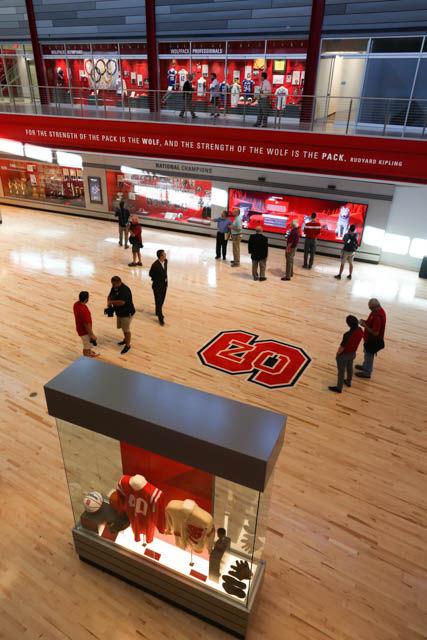Being loud at basketball games, whether it is singing along to the fight song, yelling while the other team takes a free throw or simply cheering on the Pack, has become a basketball tradition. Would basketball games even be the same if you didn’t go home with your ears ringing and your throat sore?
The bottom line is, we know that it gets loud at basketball games, but we don’t know how loud. We haven’t had a way to measure that since Wolfpack men’s basketball moved to PNC Arena in 1999.
Timothy Peeler and Tracy Fulghum were roommates when they first came to NC State in 1983, and they were able to experience the power of the noise meter and the deafening sounds that it elicited from the crowd firsthand. They started college less than six months after the 1982-83 Cardiac Pack, coached by Jim Valvano, won the NCAA tournament after one of the most memorable seasons and post-seasons in Wolfpack history.
When the men’s basketball team played in Reynolds Coliseum, a simple but inspirational piece hung from the catwalk and drove the noise higher with the lighting of each bulb. The noise meter, inspired by legendary coach Everett Case, was a tall, thin wooden rectangle that stood 10 feet tall and had 14 lights on each of its four sides: 13 white and one red.
As the crowd grew louder, the white lights would flicker on, one by one, up the meter. This of course would drive the crowds even louder until finally, the red lights would flash and the crowd would thunder.
The noise had good reason too. Peeler called the 1970s and ‘80s the “greatest era of sustained excellence of ACC basketball,” and that, along with the noise meter, led to many memorable games.
“The noise meter was one of the many things, along with camping out for tickets, getting to games early, choosing one opposing player to pick on, and the smell of fresh popcorn throughout the building that enhanced the gameday experience,” Peeler said.
Years later, Peeler and Fulghum also had the privilege of being two of the people responsible for restoring the noise meter for a final appearance at the 100th anniversary basketball game between NC State and UNC-Chapel Hill. The long-time friends helped revive the piece: purchasing new bulbs, rewiring and repainting the piece and stabilizing the unsteady structure. They then transported it to PNC Arena to celebrate the history of NC State basketball.
Fulghum, who graduated from NC State with a bachelor’s and doctorate in electrical engineering, assisted in the restoration of the noise meter and explained that the mechanics behind the famous piece were actually quite straightforward. The wooden structure had simple wiring connected to a panel with switches. A person listened to the crowd and flipped each of the switches to illuminate the lights and earn an even louder response from the crowd.
“The place went a little nuts when we rolled it out because it was such a surprise,” Peeler said. “It hadn’t been used in a men’s game since the team moved to PNC arena in 1999.” The revival of the piece struck nostalgic chords in alumni as well as Sidney Lowe and Roy Williams who both gave special mention to the noise meter in postgame press conferences.
Through their experiences as students and as alumni, Peeler and Fulghum recognized the traditional and symbolic importance of the noise meter and decided to sponsor the piece in the NC State Athletic Walk of Fame, housed in the newly renovated Reynolds Coliseum.
Fred Demarest, NC State’s associate athletics director for communications and marketing, explained the ideas behind the Walk of Fame and history itself.
“We’ve never had a space to properly tell our story, or celebrate the history of NC State Athletics,” Demarest said. “The Walk of Fame and History accomplishes this, and pays tribute to the remarkable accomplishments in our history, with an eye on our future as well.”
With permanent sponsorship of the item comes a financial commitment that both Peeler and Fulghum have decided to take responsibility for. As an English major, Peeler has used his talents, experiences, and love of NC State to publish multiple books. The majority of proceeds from his book “Legends of N.C. State Basketball,”and any future publications from Peeler, will go to the Wolfpack Club to pay for the sponsorship of the noise meter.
“Reynolds Coliseum had the greatest in-game experience of any arena [he] visited in more than 20 years as a newspaper sports reporter,” Peeler said. “The noise meter was one of the ways that [the fan’s] excitement was visible.”
Now, more than 50 years after its creation and first introduction to Reynolds Coliseum, the noise meter hangs proudly in the grand hall of its newly renovated home alongside countless other sponsored Wolfpack memorabilia. Thanks to Peeler and Fulghum, who recognized the importance of Wolfpack tradition and pride, the noise meter will continue to resonate with alumni and remind current students to stand together strongly, proudly and loudly for the Pack.








